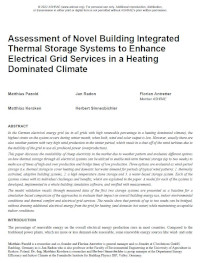
Assessment of Novel Building Integrated Thermal Storage Systems To Enhance Electrical Grid Services In A Heating Dominated Climate
Florian Antretter, Hartwig Künzel, Herbert Sinnesbichler, Jan Radon, Matthias Kersken, Matthias Pazold
Keywords: building simulation, electrical grid service, excess renewable energy, high-temperature stone storage, thermal storage, thermally activated building system
… However, usually there are also weather pattern with very high wind production in the winter period, which result in a shut-off of the wind turbines due to the inability of the grid to use all produced power (overproduction). This paper discusses the availability of cheap electricity in the market due to weather pattern and evaluates different options on how thermal storage through all electrical systems can be utilized to enable mid-term thermal storage (up to two weeks) to make use of times of high and over production and bridge times of low production. Three options are evaluated as wind-period storage (i.e. thermal storage to cover heating and domestic hot water demand for periods of typical wind pattern): 1. thermally activated, adaptive building systems, 2. a high temperature stone storage and 3. a water-based storage system. Each of the systems comes with its individual challenges and benefits, which are explained in the paper. A model for each of the systems is developed, implemented in a whole building simulation software, and verified with measurements. The model validation results through measured data of the first two storage systems are presented as a baseline for a simulation-based comparison of the approaches to evaluate their impact on overall building energy use, indoor environmental conditions and thermal comfort and electrical grid services. The results show that periods of up to two weeks can be bridged, without drawing additional electrical energy from the grid for heating (and domestic hot water) while maintaining acceptable indoor conditions.